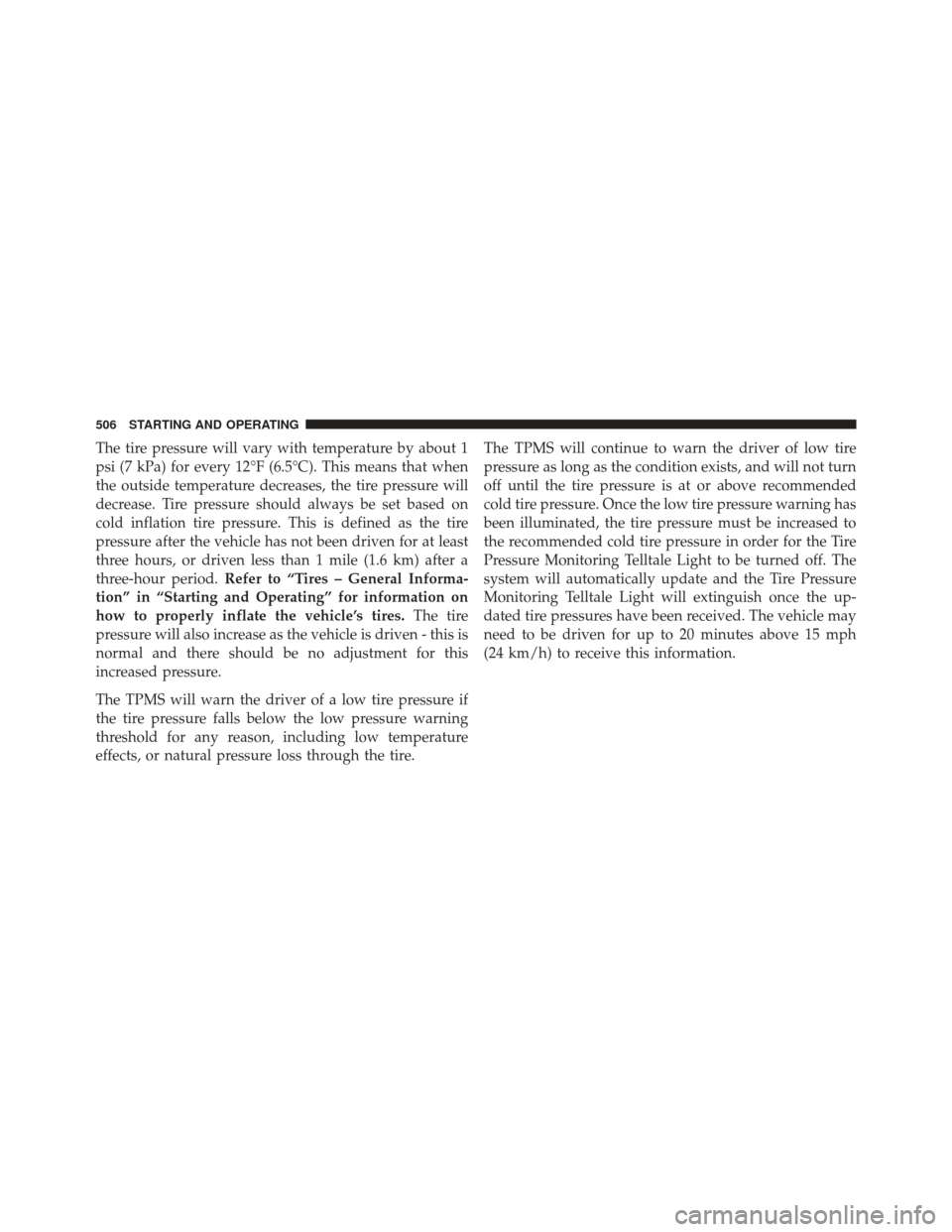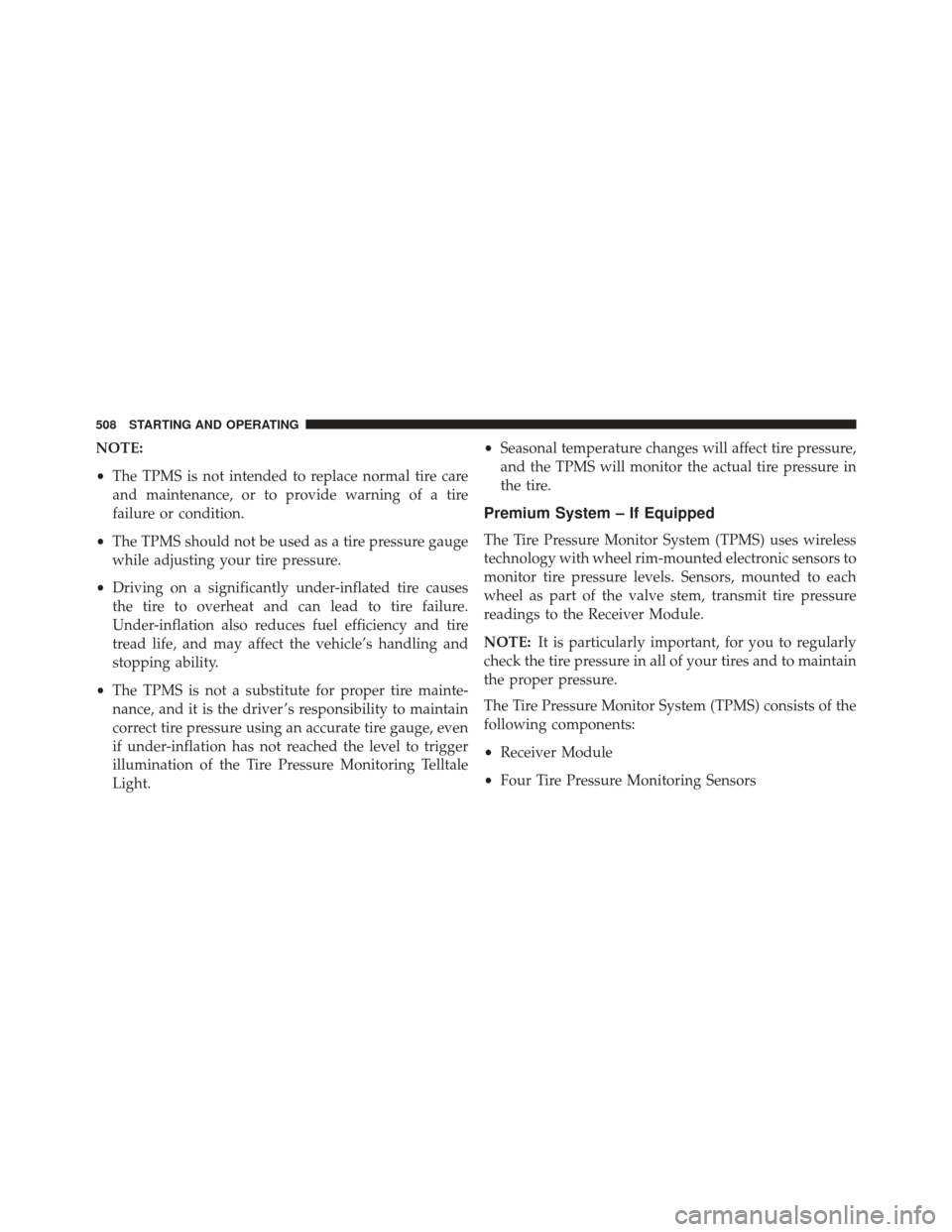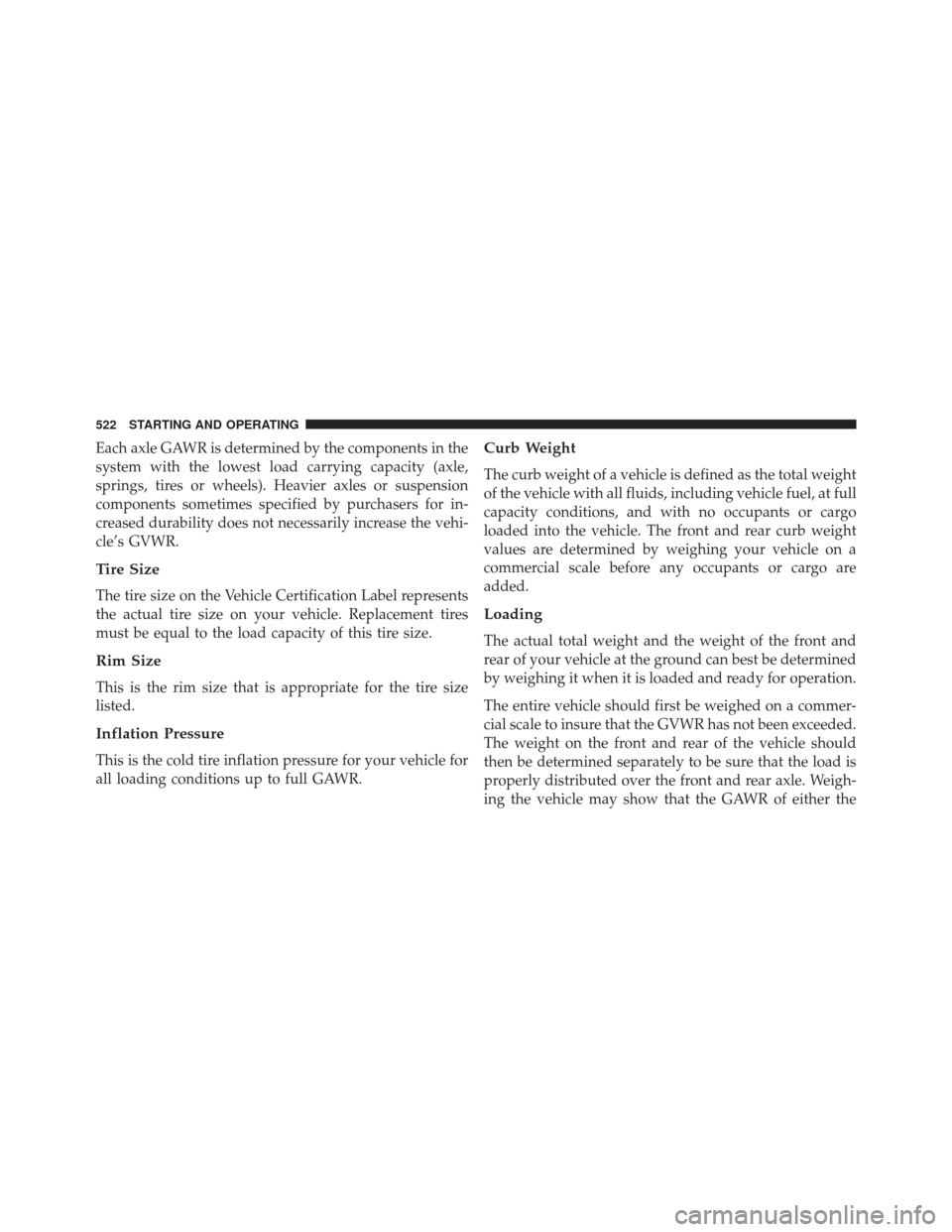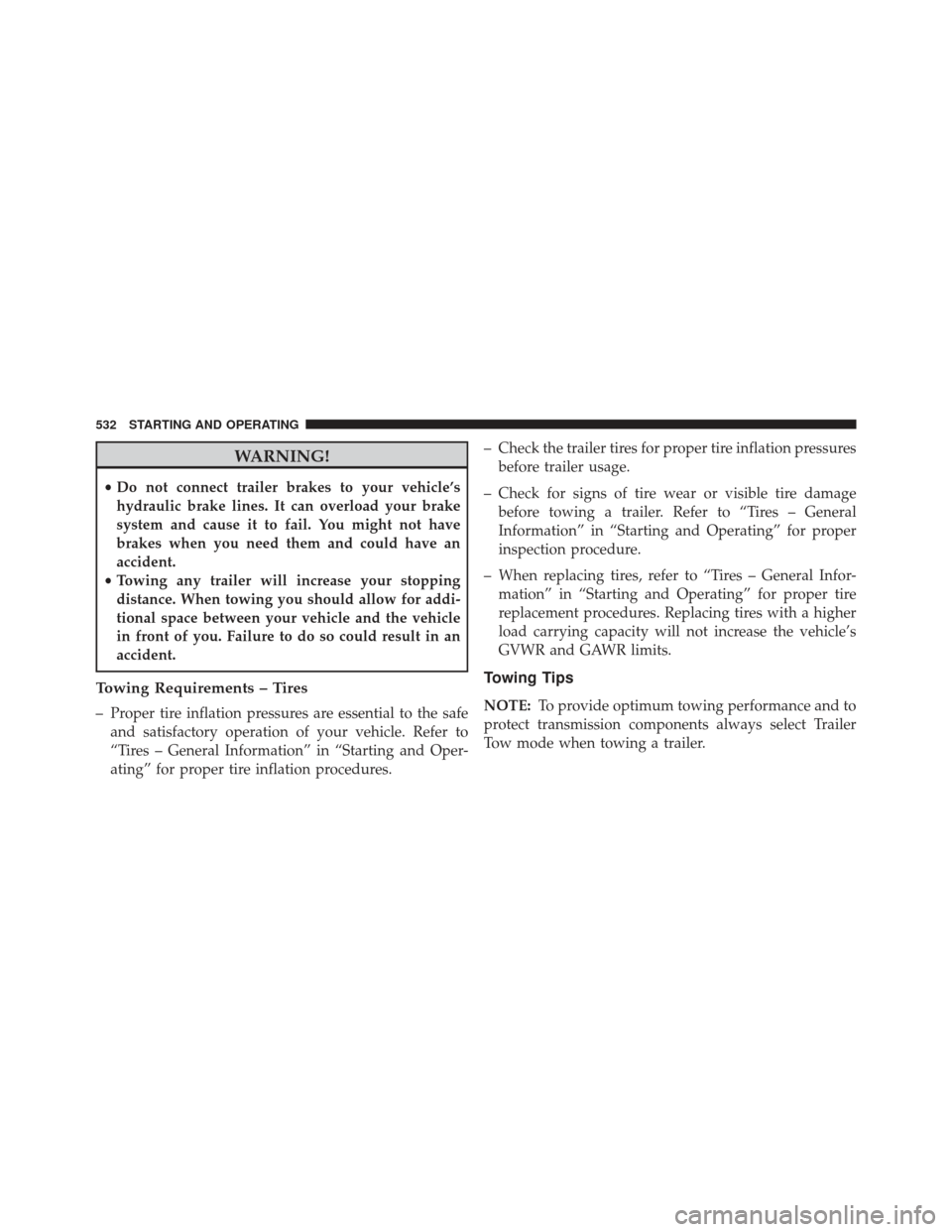Page 508 of 661

The tire pressure will vary with temperature by about 1
psi (7 kPa) for every 12°F (6.5°C). This means that when
the outside temperature decreases, the tire pressure will
decrease. Tire pressure should always be set based on
cold inflation tire pressure. This is defined as the tire
pressure after the vehicle has not been driven for at least
three hours, or driven less than 1 mile (1.6 km) after a
three-hour period.Refer to “Tires – General Informa-
tion” in “Starting and Operating” for information on
how to properly inflate the vehicle’s tires. The tire
pressure will also increase as the vehicle is driven - this is
normal and there should be no adjustment for this
increased pressure.
The TPMS will warn the driver of a low tire pressure if
the tire pressure falls below the low pressure warning
threshold for any reason, including low temperature
effects, or natural pressure loss through the tire. The TPMS will continue to warn the driver of low tire
pressure as long as the condition exists, and will not turn
off until the tire pressure is at or above recommended
cold tire pressure. Once the low tire pressure warning has
been illuminated, the tire pressure must be increased to
the recommended cold tire pressure in order for the Tire
Pressure Monitoring Telltale Light to be turned off. The
system will automatically update and the Tire Pressure
Monitoring Telltale Light will extinguish once the up-
dated tire pressures have been received. The vehicle may
need to be driven for up to 20 minutes above 15 mph
(24 km/h) to receive this information.
506 STARTING AND OPERATING
Page 510 of 661

NOTE:
•The TPMS is not intended to replace normal tire care
and maintenance, or to provide warning of a tire
failure or condition.
• The TPMS should not be used as a tire pressure gauge
while adjusting your tire pressure.
• Driving on a significantly under-inflated tire causes
the tire to overheat and can lead to tire failure.
Under-inflation also reduces fuel efficiency and tire
tread life, and may affect the vehicle’s handling and
stopping ability.
• The TPMS is not a substitute for proper tire mainte-
nance, and it is the driver ’s responsibility to maintain
correct tire pressure using an accurate tire gauge, even
if under-inflation has not reached the level to trigger
illumination of the Tire Pressure Monitoring Telltale
Light. •
Seasonal temperature changes will affect tire pressure,
and the TPMS will monitor the actual tire pressure in
the tire.
Premium System – If Equipped
The Tire Pressure Monitor System (TPMS) uses wireless
technology with wheel rim-mounted electronic sensors to
monitor tire pressure levels. Sensors, mounted to each
wheel as part of the valve stem, transmit tire pressure
readings to the Receiver Module.
NOTE: It is particularly important, for you to regularly
check the tire pressure in all of your tires and to maintain
the proper pressure.
The Tire Pressure Monitor System (TPMS) consists of the
following components:
• Receiver Module
• Four Tire Pressure Monitoring Sensors
508 STARTING AND OPERATING
Page 524 of 661

Each axle GAWR is determined by the components in the
system with the lowest load carrying capacity (axle,
springs, tires or wheels). Heavier axles or suspension
components sometimes specified by purchasers for in-
creased durability does not necessarily increase the vehi-
cle’s GVWR.
Tire Size
The tire size on the Vehicle Certification Label represents
the actual tire size on your vehicle. Replacement tires
must be equal to the load capacity of this tire size.
Rim Size
This is the rim size that is appropriate for the tire size
listed.
Inflation Pressure
This is the cold tire inflation pressure for your vehicle for
all loading conditions up to full GAWR.
Curb Weight
The curb weight of a vehicle is defined as the total weight
of the vehicle with all fluids, including vehicle fuel, at full
capacity conditions, and with no occupants or cargo
loaded into the vehicle. The front and rear curb weight
values are determined by weighing your vehicle on a
commercial scale before any occupants or cargo are
added.
Loading
The actual total weight and the weight of the front and
rear of your vehicle at the ground can best be determined
by weighing it when it is loaded and ready for operation.
The entire vehicle should first be weighed on a commer-
cial scale to insure that the GVWR has not been exceeded.
The weight on the front and rear of the vehicle should
then be determined separately to be sure that the load is
properly distributed over the front and rear axle. Weigh-
ing the vehicle may show that the GAWR of either the
522 STARTING AND OPERATING
Page 534 of 661

WARNING!
•Do not connect trailer brakes to your vehicle’s
hydraulic brake lines. It can overload your brake
system and cause it to fail. You might not have
brakes when you need them and could have an
accident.
• Towing any trailer will increase your stopping
distance. When towing you should allow for addi-
tional space between your vehicle and the vehicle
in front of you. Failure to do so could result in an
accident.
Towing Requirements – Tires
– Proper tire inflation pressures are essential to the safe and satisfactory operation of your vehicle. Refer to
“Tires – General Information” in “Starting and Oper-
ating” for proper tire inflation procedures. – Check the trailer tires for proper tire inflation pressures
before trailer usage.
– Check for signs of tire wear or visible tire damage before towing a trailer. Refer to “Tires – General
Information” in “Starting and Operating” for proper
inspection procedure.
– When replacing tires, refer to “Tires – General Infor- mation” in “Starting and Operating” for proper tire
replacement procedures. Replacing tires with a higher
load carrying capacity will not increase the vehicle’s
GVWR and GAWR limits.
Towing Tips
NOTE: To provide optimum towing performance and to
protect transmission components always select Trailer
Tow mode when towing a trailer.
532 STARTING AND OPERATING
Page 657 of 661

Inflation Pressures..................... .495
Life of Tires .......................... .502
Load Capacity ........................ .489
Pressure Monitor System (TPMS) ...........505
Pressure Warning Light ..................318
Quality Grading ...................... .637
Radial .............................. .497
Replacement ......................... .502
Rotation ............................ .504
Safety .............................. .483
Sizes ............................... .485
Spare Tire ........................... .539
Spinning ............................ .500
Tread Wear Indicators ...................501
Tire Safety Information .....................483
Tongue Weight/Trailer Weight ................528
Tow/Haul Indicator Light ...................317
Tow Hooks, Emergency .....................553
Towing ............................... .52324-Hour Towing Assistance
................152
Behind a Motorhome ....................534
Disabled Vehicle ...................... .555
Guide .............................. .527
Recreational ......................... .534
Weight ............................. .527
Towing Assistance ........................ .152
Towing Vehicle Behind a Motorhome ...........534
Traction Control ......................... .474
Trailer Sway Control (TSC) ..................480
Trailer Towing .......................... .523
Cooling System Tips ....................534
Hitches ............................. .526
Minimum Requirements ..................529
Trailer and Tongue Weight ................528
T
railer Towing Guide ...................... .527
Trailer Weight ........................... .527
Transfer Case ........................... .586
Maintenance ......................... .586
10
INDEX 655
Page:
< prev 1-8 9-16 17-24